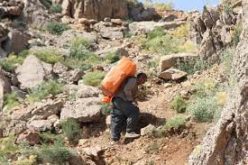RFL/RE – The families of victims of mass executions in Iran in 1988 have expressed outrage over construction and other changes made at the Khavaran cemetery, which they believe holds the remains of their loved ones.
A letter signed by nearly 800 members of the victims’ families and sent to Javid Rahman, the UN’s special rapporteur on the human rights situation in Iran, demands that the Islamic republic “stop harassing and threatening the grieving families.”
Videos and images published on social media in May show that a high concrete wall and security camera fixtures have been installed around the perimeter of the cemetery, known by many Iranians as the “place of the damned.”
According to eyewitnesses, in addition to the surveillance cameras, a new door has been installed at the entrance to the cemetery and the layers of security around the cemetery are being intensified.
Families and activists see the new constructions as a brazen attempt by authorities to further restrict access to the Khavaran cemetery in their efforts to erase the memory of the dead.
Through his fatwa in 1988, Ayatollah Ruhollah Khomeini paved the way for the immediate execution of Iranian prisoners deemed loyal to the Mujahedin-e Khalq Organization (MKO), a political-militant organization that advocated the overthrow of Iran’s clerical regime.
Many of the prisoners had been rounded up for even the slightest perceived affiliation to the MKO. The fatwa eventually encompassed all left-wing opponents of the regime, including communists, Trotskyists, Marxist-Leninists, and others.
The cemetery in the east of the capital was traditionally a final resting place for members of religious minorities, who were interred there to keep them separate from the graves of Muslims. But following the mass executions, Khavaran became best known as a secret burial ground for some of the thousands killed.SEE ALSO:Hounded Beyond The Grave: Dead Iranian Dissidents Not Allowed To Rest In Peace
The graves at Khavaran are unmarked, and Tehran has for decades barred families of the dead from mourning there and punished those who left flowers and mementos.
The strict official stance has contributed to accusations that Tehran has attempted to cover up the killings of dissidents and religious minorities by death squads and has even desecrated the burial sites of victims.
The Iranian government has never acknowledged the mass executions nor provided any information about the number of prisoners killed.
 Shabtabnews In this dark night, I have lost my way – Arise from a corner, oh you the star of guidance.
Shabtabnews In this dark night, I have lost my way – Arise from a corner, oh you the star of guidance.



